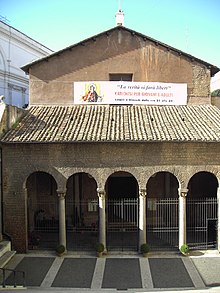San Vitale, Rome
This article needs additional citations for verification. (September 2017) |
| Basilica of Sts. Vitalis, Valeris, Gervase and Protase Basilica di Santi Vitale e Compagni Martiri in Fovea Template:It icon Basilica Ss. Vitalis, Valeriae, Gervasii et ProtasiiTemplate:La icon | |
|---|---|
 Façade of the Basilica of San Vitale | |
| Religion | |
| Affiliation | Roman Catholic |
| Ecclesiastical or organizational status | Minor basilica |
| Leadership | Adam Maida |
| Year consecrated | 401 |
| Location | |
| Location | |
| Geographic coordinates | 41°53′58.8″N 12°29′27.1″E / 41.899667°N 12.490861°E |
| Architecture | |
| Type | Church |
| Style | Roman |
| Groundbreaking | ca. 400 |
| Specifications | |
| Direction of façade | SE |
| Length | 60 metres (200 ft) |
| Width | 18 metres (59 ft) |
| Website | |
| Official website | |
The Basilica of Sts. Vitalis, Valeris, Gervase and Protase (Template:Lang-it, Template:Lang-la) is a titular minor basilica church in Rome. The Roman Catholic church is commonly named Basilica di San Vitale. The Cardinal Priest of the Titulus S. Vitalis is Adam Maida.
History
The basilica was built in 400 with funds provided by Vestina, a wealthy dowager,[1] and was consecrated by Pope Innocent I in 401/402. The dedication to St. Vitalis and his family (Saint Valeria, his wife, and Sts. Gervasius and Protasius, their sons) is dated to 412. This church is recorded as Titulus Vestinae in the acts of the 499 synod of Pope Symmachus, and three presbyters are listed.
San Vitale was restored several times, the most important being the rebuilding by Pope Sixtus IV before the Jubilee of 1475, and then in 1598, 1938 and 1960. The floor level of the church is currently located several metres below the level of the street on which it is located, the (via Nazionale).
Exterior
The portico is the most ancient part of the church, possibly dating back to the 5th century. It was altered at the end of the 16th century. The inscription on the portico, with the arms of Pope Sixtus IV, dates from this time. Pope Pius IX built the staircase to the 5th century portico in 1859.

Interior
The church has a single nave, with walls frescoed with scenes of martyrdom, among which a Martyrdom of St Ignatius of Antioch, in which a ruined Colosseum is depicted.
The apsis, original of the 5th century, is decorated with a fresco by Andrea Commodi, The Ascent to Calvary.
Cardinal Priest of the Basilica di San Vitale
Among the previous titulars, Gennaro Cesio, appointed in 494 by Pope Gelasius I, and St. John Fisher, martyred in 1535 by Henry VIII. The current Cardinal Priest of the Titulus S. Vitalis is Adam Maida.
Free bread was distributed to the poor by the church according to the will of a Roman nobleman, Francesco Silla.
References
- ^ David Hunt, Chapter VIII of The Cambridge Ancient History, Volume XIII, p.251
Bibliography
- Armellini, Mariano (1891). Le chiese di Roma dal secolo IV al XIX (in Italian). Roma: Edizioni del Pasquino. pp. 187–189.
- Krautheimer, Richard; Spencer Corbett; Volfango Frankl (1970). Corpus basilicarum Christianarum Romae: Le basiliche cristiane antiche di Roma. Monumenti di antichità cristiana : ser. 2, v. 2. Citta del Vaticano: Pontificio istituto di archeologia cristiana. pp. 313 ff.

